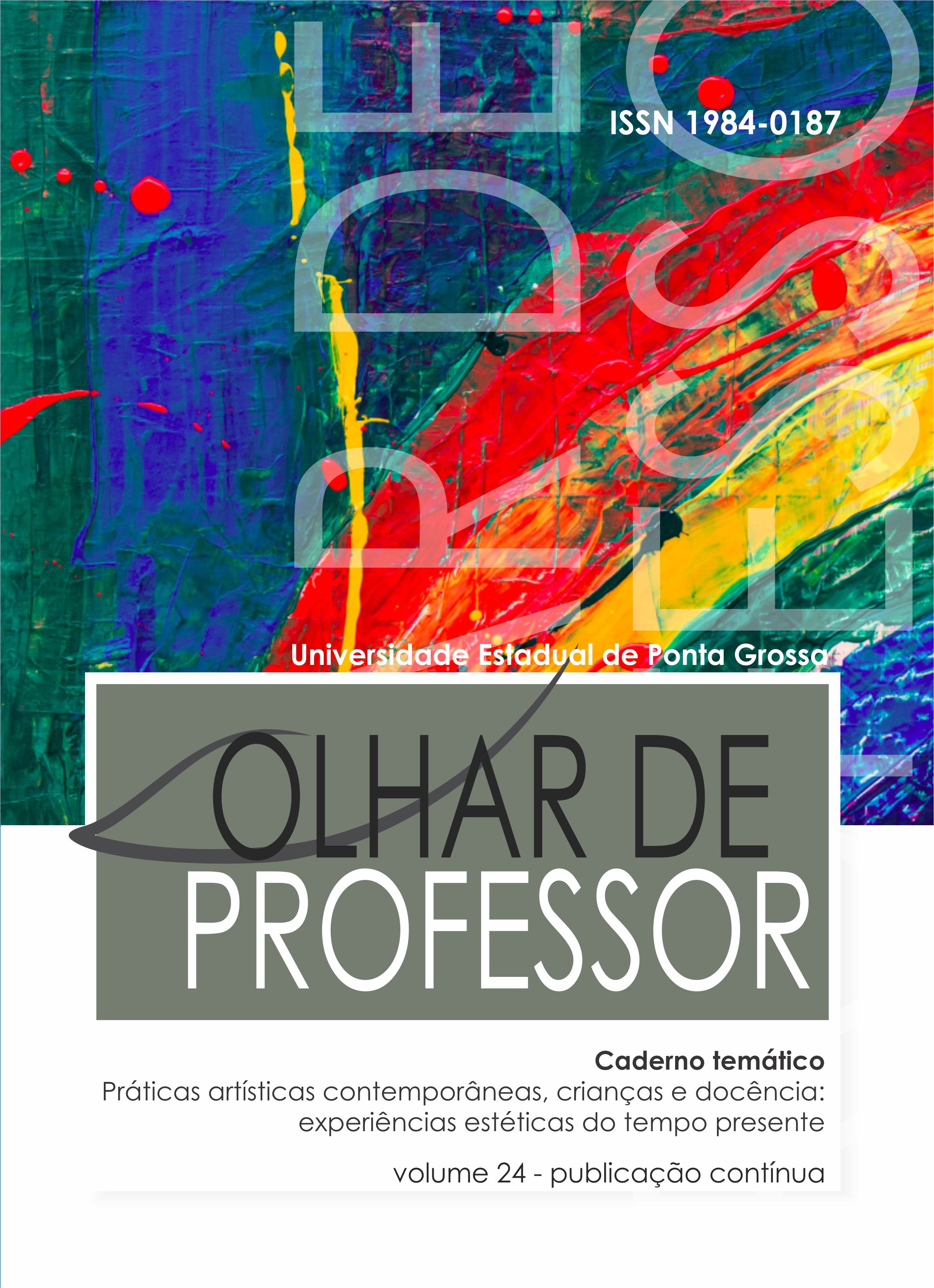Kneading, scribblin, to tear and move (yourself): propositions for approach contemporary art Of children's in early Childhood Education
Main Article Content
Abstract
What theoretical-methodological arguments can favor rapprochement between children and Contemporary Art? In this reflection, we aim to argue in favor of proposals for working with Contemporary Art in kindergarten and Early Childhood Education centers. We carried out a bibliographical investigation into the children's actions and the characteristics of Contemporary Art. Therefore, we selected from Base Nacional Comum Curricular (National Common Curricular Base) - BNCC (2018) ten learning and development objectives of Early Childhood Education and brought them closer to Contemporary Art. Subsequently, we presented four arguments that can support the practices of Early Childhood Education teachers in terms of working with Contemporary Art, and then, we exemplified these arguments with works by contemporary artists. Finally, we highlighted the importance of working with Contemporary Art in Early Childhood Education.
Downloads
Article Details
Authors who publish in this journal agree with the following terms:
a) Authors keep the copyrights and concede the right of its first publication to the magazine. The work piece must be simultaneously licensed on the Creative Commons Attribution License which allows the paper sharing, and preserves both the author identity and the right of first publication to this magazine.
b) Authors are authorized to assume additional contracts separately, to not-exclusively distribution of the paper version published in this magazine (e.g.: publish in institutional repository or as a book chapter), with the author identity recognition and its first publication in this magazine.
c) Authors are permitted and stimulated to publish and distribute their papers online (e.g.: in institutional repository or on their personal webpage), considering it can generate productive alterations, as well as increase the impact and the quotations of the published paper.
d) This journal provides public access to all its content, as this allows a greater visibility and reach of published articles and reviews. For more information on this approach, visit the Public Knowledge Project, a project that developed this system to improve the academic and public quality of the research, distributing OJS as well as other software to support the publication system of public access to academic sources.
e) The names and e-mail addresses on this site will be used exclusively for the purposes of the journal and are not available for other purposes.

This work is licensed under a Creative Commons Attribution 4.0 International License.
References
BERTASI, Andressa Thaís Favero; CARVALHO, Rodrigo Saballa de. As produções gráfico-plásticas das crianças. In: CUNHA, Susana Rangel Vieira da; CARVALHO, Rodrigo Saballa de. Arte Contemporânea e Educação Infantil: crianças observando, descobrindo e criando, 1. ed. Porto Alegre: Mediação, 2017a. p.128.
BECKER, Aline da Silveira. História e imagens: A visualidade produzindo infâncias. In: MARTINS, Raimundo; TOURINHO,Irene (orgs.) Cultura Visual e Infância: quando as imagens invadem a escola...Santa Maria: Editora da UFSM, 2010, p. 89-104.
BORGES, Camila Bettim. Respingos, colagens, vozes, sensações. In: CUNHA, Susana Rangel. Arte Contemporânea e Educação Infantil: crianças observando, descobrindo e criando, 1.ed. Porto Alegre: Mediação, 2017, p. 65 -73.
BRASIL. Base Nacional Comum Curricular. Brasília: MEC, 2018. Disponível em:
CARVALHO, Rodrigo Saballa de. Entre As Culturas da Infância e a Rotina Escolar: em busca do sentido do tempo na educação infantil. Revista Teias, Rio de Janeiro. v. 16, n. 41, p.124-141, abr./jun. 2015.
CATTANI, Icleia Barbosa. Mestiçagens da Arte Contemporânea. Porto Alegre: Editora da UFRS, 2007.
COLETO, Daniela Cristina. A Importância da Arte para a formação da criança. Revista Conteúdo, Capivari, v. 1, n. 3, p. 137-152, jan./jul. 2010.
CUNHA, Susana Rangel Vieira da; CARVALHO, Rodrigo Saballa de. Arte Contemporânea e Educação Infantil: crianças observando, descobrindo e criando, 1. ed. Porto Alegre: Mediação, 2017. p.128.
CUNHA, Susana Rangel Vieira da. Pintando, bordando, rasgando, desenhando e melecando na educação infantil. In. CUNHA, Susana Rangel Vieira da (Org.). Cor, som e movimento: a expressão plástica, musical e dramática no cotidiano da criança. Porto Alegre: Mediação, 1995, p. 7-36.
_______. Imagens na educação infantil como pedagogias culturais. In: MARTINS, Raimundo; TOURINHO, Irene (Org.). Pedagogias culturais. Santa Maria: Ed. da UFSM,
2014. p. 199-224.
GIL, Antônio Carlos. Como elaborar projetos de pesquisa. São Paulo: Atlas, 2002.
HOFFMANN, Jens. (Curadoria) de A a Z. 1ª ed. Rio de Janeiro: Cobogó. 2017. p. 100.
IAVELBERG, Rosa. Desenho na Educação Infantil. São Paulo: Editora Melhoramentos, 2013.
_______. A Base Nacional Comum e a formação dos professores de arte. Revista Horizontes, São Paulo, v. 36, p. 74-84, jan./abr. 2018.
LOPONTE, Luciana Gruppelli. Arte e metáforas contemporâneas para pensar infância e educação. Revista Brasileira de Educação, Rio de Janeiro, v. 13, n. 37, p. 112- 122, jan./abr. 2008.
MARTINS, Mirian Celeste (Coord.). Curadoria educativa: inventando conversas. Reflexão e Ação - Revista do Departamento de Educação/UNISC - Universidade de Santa Cruz do Sul, Santa Cruz do Sul, v. 14, n.1, p. 9-27, jan. /jun. 2006.





